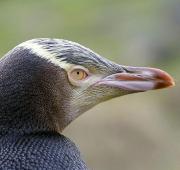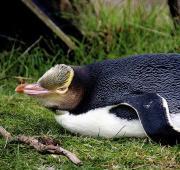 The yellow-eyed penguin is one of the few penguin species found north of the Antarctic Ocean, and as it's name suggests, this species of penguin is easily idenitfied by it's yellow coloured eyes and bright yellow band that runs from it's eyes round the back of the yellow-eyed penguin's head.
The yellow-eyed penguin is one of the few penguin species found north of the Antarctic Ocean, and as it's name suggests, this species of penguin is easily idenitfied by it's yellow coloured eyes and bright yellow band that runs from it's eyes round the back of the yellow-eyed penguin's head.



The yellow-eyed penguin is a carnivorous animal, that like all other penguin species, survives on a diet that is only comprised of marine animals. Krill and small crustaceans make up the bulk of the yellow-eyed penguin's diet along with larger organisms including squid and various species of fish.
The yellow-eyed penguin is usually found nesting in the forests and scrub that line the New Zealand coast and although historically undisturbed, the yellow-eyed penguin now has a number of land-dwelling predators including cats, dogs and foxes along with rats and weasels that hunt their eggs.
On average, the yellow-eyed penguin breeds once a year, forming pairs that usually remain faithful to one another. The female yellow-eyed penguin lays two eggs in her nest in the forest which are incubated by both parents for up to a couple of months, when only one of the eggs will usually hatch. The yellow-eyed penguin chicks are fed and kept warm by their parents and remain with them until the chicks are nearly a year old.
Today, the yellow-eyed penguin listed as an endangered animal with an estimated wild population of less than 4,000 individuals. It is now the rarest penguin in the world due to deforestation and the introduction of mammalian predators.

